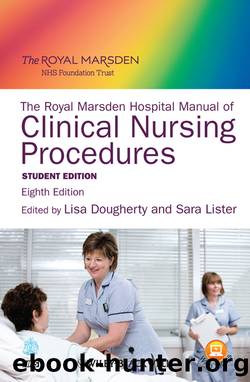The Royal Marsden Hospital Manual of Clinical Nursing Procedures by Lisa Dougherty & Sara Lister

Author:Lisa Dougherty & Sara Lister
Language: eng
Format: epub
ISBN: 9781444361308
Publisher: John Wiley & Sons, Ltd.
Published: 2011-08-23T16:00:00+00:00
Music
The use of taped music in the healthcare setting can also provide relaxation and distraction from pain (Beck 1991, Good 1996, Heiser et al. 1997). Setting up a library of taped music (e.g. easy listening, classical) and having personal stereos available for patient use is a simple way to provide patients with relaxing music.
Art
Art therapies have also been used to assist the patient in moving the focus of attention away from the physical sensation of pain to other aspects of the person (Trauger-Querry and Haghighi 1999). The skills of an art therapist are required to ensure the successful use of this intervention.
Physical interventions
In addition to psychological interventions, a number of physical interventions can be helpful in reducing pain.
Comfort measures
Simple comfort measures such as careful body positioning (for example, supporting a painful arm on a pillow) and the use of soft and therapeutic mattresses (Ballard 1997) can help to improve patient comfort and pain control.
Exercise
Both passive and active physical exercises may benefit patients by increasing range of motion (Feine and Lund 1997), preventing joint stiffness and muscle wasting which may further compound pain problems. Exercise should always be tailored to the patientâs tolerance and stamina. A simple exercise regimen which is practised regularly and supervised by a therapist can help patients feel better and more in control as well as having benefits in terms of pain relief.
Rest
In addition to exercise, teaching patients to rest comfortably in any position when in pain is a meaningful action and the base from which a person can learn to move more easily (OâConnor and Webb 2002). A person with a terminal illness may experience restriction of movement and neuromuscular pain with increased tension. For these patients, learning to rest and letting go of any tension can be helpful.
Transcutaneous electrical nerve stimulation
Transcutaneous electrical nerve stimulation (TENS) (Figure 9.13) is thought to work by sending a weak electrical current through the skin to stimulate the sensory nerve endings. Depending on the stimulation parameters used, TENS is thought to modulate pain impulses by closing the gate to pain transmission within the spinal cord by stimulating the release of natural pain-relieving chemicals in the brain and spinal cord (King 1999).
Figure 9.13 TENS machine.
Download
This site does not store any files on its server. We only index and link to content provided by other sites. Please contact the content providers to delete copyright contents if any and email us, we'll remove relevant links or contents immediately.
What's Done in Darkness by Kayla Perrin(25499)
Shot Through the Heart: DI Grace Fisher 2 by Isabelle Grey(18218)
Shot Through the Heart by Mercy Celeste(18160)
The Fifty Shades Trilogy & Grey by E L James(17774)
The 3rd Cycle of the Betrayed Series Collection: Extremely Controversial Historical Thrillers (Betrayed Series Boxed set) by McCray Carolyn(13189)
The Subtle Art of Not Giving a F*ck by Mark Manson(12908)
Scorched Earth by Nick Kyme(11831)
Stepbrother Stories 2 - 21 Taboo Story Collection (Brother Sister Stepbrother Stepsister Taboo Pseudo Incest Family Virgin Creampie Pregnant Forced Pregnancy Breeding) by Roxi Harding(11037)
Drei Generationen auf dem Jakobsweg by Stein Pia(10216)
Suna by Ziefle Pia(10185)
Scythe by Neal Shusterman(9259)
International Relations from the Global South; Worlds of Difference; First Edition by Arlene B. Tickner & Karen Smith(8608)
Successful Proposal Strategies for Small Businesses: Using Knowledge Management ot Win Govenment, Private Sector, and International Contracts 3rd Edition by Robert Frey(8418)
This is Going to Hurt by Adam Kay(7693)
Dirty Filthy Fix: A Fixed Trilogy Novella by Laurelin Paige(6450)
He Loves Me...KNOT by RC Boldt(5804)
How to Make Love to a Negro Without Getting Tired by Dany LaFerrière(5378)
Interdimensional Brothel by F4U(5303)
Thankful For Her by Alexa Riley(5159)
